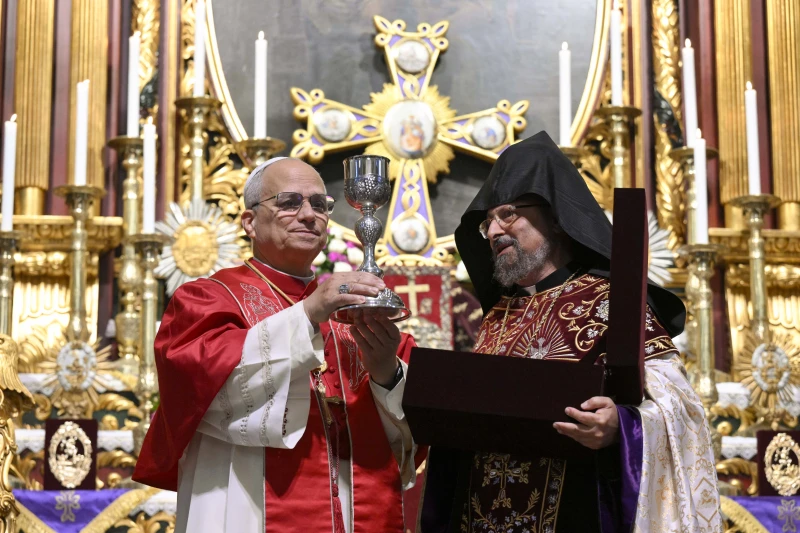After pleas for peace in Gaza and Ukraine, Pope Leo lands in crisis-hit Lebanon

BEIRUT, Lebanon (RNS) – Pope Leo XIV left Turkey on Sunday (Nov. 30), for the capital of Lebanon, Beirut, where he met with government officials in the conflict ridden and financially troubled country, home to one of the largest Christian communities in the Middle East.
While on the plane between the two countries, Leo spoke to reporters on board about the significance of his visit to Turkey, where he commemorated the 1700th anniversary of the First Ecumenical Council of Nicaea and voiced his message for peace, especially in Ukraine and in the Holy Land. The pope expressed his hope that he and the Patriarch of Constantinople Bartholomew might in 2033 celebrate the 2o00th anniversary of the death and resurrection of Jesus together in the Holy Land.
The pope underlined the Holy See’s support for a two state solution, with an Israeli state living side by side with an independent Palestinian state, but recognized that “Israel still doesn’t accept this solution.” He told reporters that he discussed the issue with Turkish President Recep Tayyip Erdogan, who, Leo said, is aligned with the Holy See’s proposal and that Turkey “has an important role it could play.”
The war in Ukraine is also a main concern for the Vatican, which has been actively involved with offering aid and support to civilians on the ground. Leo told reporters he had that, given Erdogan’s personal relationship with the leaders of Ukraine, Russia and the United States, “he might be able to help promote dialogue, a ceasefire and a way to resolve this conflict.”
After landing in Beirut, the pope met with the political leaders of Lebanon, a country plagued by a crippling financial crisis, mass displacement, widespread unemployment and conflict with Israel.
In 2020, a powerful explosion at the port of Beirut left almost 300 dead and thousands wounded. The event marked a kind of hinge in Lebanon’s recent history, wiping out significant infrastructure and food supplies and deepening an economic collapse that was already one of the worst in the world. Mass protests and demands for accountability eventually led to the government resigning, leaving a vacuum of political power and years of turmoil and turnover. In that time the militia group Hezbollah continued to expand both militarily and politically, often providing critical social services.

In 2024 a new wave of violence broke out between Israel and Hezbollah, especially in the south of the country, in the Beqaa Valley. Despite a tenuous ceasefire agreement on Nov. 27, 2024, Israeli drone attacks on Lebanon have continued throughout 2025 and, on November 23, an Israeli drone attack on Beirut killed Hezbollah’s chief of staff. Despite Hezbollah’s weakened position in the country, its members could still be seen holding their flags as they greeted the pope entering the city of Beirut. Despite Hezbollah’s weakened position in the country, its members could still be seen holding their flags as they greeted the pope entering the city of Beirut.
In January 2025, after years of political paralysis, the country elected President Joseph Aoun, a Maronite Christian and a sign for hope for many in the country.
“There is a shining quality that distinguishes the Lebanese: you are a people who do not give up, but in the face of trials, always know how to rise again with courage,” Leo told Lebanese leaders. “Your resilience is an essential characteristic of authentic peacemakers, for the work of peace is indeed a continuous starting anew.”
The motto for Leo’s trip to Lebanon was “Blessed are the peacemakers,” encompassing his message for this beleaguered country and its struggling populace. In a special way, he is committed to rekindling its Christian flock, which risks shrinking as a growing number of youth seek better lives and opportunities elsewhere.
“There are times when it is easier to flee, or simply more convenient to move elsewhere,” Leo said in his speech at the Presidential Palace in Beirut, adding that “it takes real courage and foresight to stay or return to one’s own country, and to consider even somewhat difficult situations worthy of love and dedication.”
While the population of Lebanon is roughly 5.8 million people, there are an estimated 15 million Lebanese living outside the country. About 63% of the country’s current population is Muslim, according to a 2025 report by Aid To the Church in Need, a Catholic aid organization. About 32% are Christians, most of them Catholics who belong to six Eastern Churches and one Latin Church. Since the 1990’s, the Christian population has dropped from 62% to the current 30%, due to declining birthrates and emigration.
Leo is the third pope to visit the country, which Pope Francis had hoped to visit during his pontificate but could not because of the regional instability and his declining health. When Saint Pope John Paul II visited the country in 1997, he praised Lebanon as a “a message of coexistence, pluralism and freedom for East and West.”

According to the Lebanese-American historian and human-rights scholar Habib Malik, “the notion of Lebanon as a message or model is a bit romantic, given how much that model has failed of late.” Instead, he said, the pope should focus on what truly makes Lebanon unique: it’s freedom, especially it’s religious freedom.
“Despite all its myriad problems and corruption of leadership and so forth, the fact remains that the Christians in Lebanon are freer than other native rooted Christian communities in the Arab world,” he said.
Malik’s father, Charles Malik, was a renowned human rights scholar and had a leading role in writing the Universal Declaration of Human Rights, including article 18, which enshrines the right to change one’s religion.
In Lebanon, Leo has the opportunity to find a populace keen to hear his words of advice and encouragement, Malik said. In his meeting with officials, the pope had the opportunity to join the calls of the international community for Lebanon to seize control of its state and government and seize the arms and weapons of the Hezbollah militia, centralizing military power, he added.
But Malik underlined that the most important event for the country might be when he joins with youth on Monday (Dec. 1), to encourage them in their faith but also to urge them to remain in the country and contribute to building a peaceful and tolerant future.
 Bread is one of Judaism’s oldest civic technologies. It binds memory to practice, heritage to the week’s rhythms.
Bread is one of Judaism’s oldest civic technologies. It binds memory to practice, heritage to the week’s rhythms.




 Instead of giving haters the attention they crave and adding to their self-importance, we need to crush their souls by humiliating them.
Instead of giving haters the attention they crave and adding to their self-importance, we need to crush their souls by humiliating them.